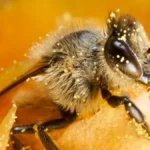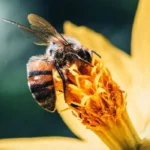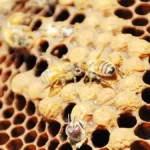This article delves into basic bee anatomy. How many legs do bees have? Do bees have tongues? Do bees have antennae? And what exactly is a bee sting? If you have ever been stung you may be rather shocked to find out you literally got laid by a bee…. Let us take a look at the parts of a bee.
How Many Legs Do Bees Have?
I have often had people ask me interesting questions assuming bees bend the rules of biology. One such question, which comes up a lot is “How many legs do bees have?”.
Bees are insects – so this means that they follow the general rules of insects. Insects by definition have 6 legs. This is quite a convenient number as it allows a lot of control over scurrying around inside flowers and so on – imagine if they had ten legs or 100’s like some other creatures – it would get messy.
Bee’s legs are cleverly adapted to the work a bee does.
Front Of Forelegs
The front legs are suited to combing the pollen granules off the head of the bee. Specifically to get the pollen off the hair on their eyes. You can imagine how important it is for bees to be able to see – they use the Sun to navigate. If their eyes get covered in pollen they will be lost.
Hind Legs
The hind legs of the bee are adapted for carrying pollen. These legs have pollen baskets – a hairy specialized area where pollen is packed. Pollen baskets are called corbicula. Corbicula is the Latin word for a little basket. Bees use their forelegs to comb pollen off their furry body, and then mix this with a bit of nectar extruded on their proboscis (tongue). This makes the pollen sticky and it is then packed on the corbicula.

In this photograph, a Cape Honeybee, Apis meliffera capensis, is seen gathering pollen from a wildflower. Note the dark abdomen of the Cape bee and its small size compared to other bees. Photograph: Dr. Jim Cambray
How Many Legs Does A Queen Bee Have?
How many legs do bees have? The queen is a bee too. A queen is genetically identical to a worker bee but just has the ability to mate and lay eggs. So she has the same number of legs as a worker, a drone, or in fact any insect – insects have six legs – or are hexapods.
Do Bees Have Tongues?
A tongue generally refers to the fleshy muscular organ in the mouth of vertebrates. Given that bees are not vertebrates but are arthropods, and more specifically insects, we tend to refer to their equivalent of a tongue as a proboscis. These terms are actually quite fluid, however.
What Is A Proboscis?
A proboscis is a specialized mouthpart that is long. Biology is a bit of a confusing area in terms of names used for things. An elephant has a long nose which is sometimes called a proboscis. A bee has a long tongue-like straw thing that is also called a proboscis. So let us not delve into the fact that the English language is a genuinely confusing thing, that science is far from perfect, and that the combination of English and Science is really confusing. Let us just look at what this proboscis/bee tongue thing actually does.

Does Proboscis Size Matter?
The bee proboscis is about 0,25″ (6.5mm) long. Worker bees vary in size quite a bit from race to race, but let’s just say a big strong worker is 5/8th (16mm) of an inch – and that is a really big worker – then that means her proboscis is 40% of her body length.
Let us put that in perspective – an average human has a tongue that is about 3″ (7.5cm) long. That means for me, if I was proportioned like a bee, I would have a tongue two a half feet long. This would really help right now because my mug of hot chocolate is on the other side of the table and I would not need to stand up to go and fetch it.
For bees, the proboscis size really matters. The longer the proboscis, the more likely they are able to find the nectar in the heart of the flower. We find that certain races of bees have evolved longer or shorter probosci so that they area adapted to flowers in their area. This is a beautiful elegant study of bumblebees in South America showing how a probosci’s length plays a role in the type of flower the bees work on.
How Does The Proboscis Work?
Basically, the core of the proboscis is a bit like a straw. The bees stick that into the flower and suck the nectar up through the proboscis. The proboscis can be used for rapid high flow transfer – if you watch a bee drinking water you can see she pumps her body and creates a powerful suction force. The same happens if she has been exposed to smoke and is filling her honey stomach with nectar from the hive. When bee robs other hives they also use this high transfer rate method of pumping liquid rapidly.
In the case where a more scarce resource is being collected, they have a smaller tube inside the proboscis that can lick around and extend into small spaces. This works a bit like a dog lapping water up. Using this extension the bees can access diffuse nectar inside flowers that do not produce big pools of nectar.
In summary – the proboscis works really well! I have watched bees move 50 gallons of sugar water from a feeding trough to their hives in a few hours. I have also had bees rob honey off the back of my pickup nearly as fast as I could harvest it from hives (don’t harvest honey at midday during a nectar dearth). The bee proboscis is an incredibly efficient part of the bee.
Can Liquids Flow Out Of The Proboscis?
For us as humans our tongue is a sort of one-way thing – it helps us eat and swallow things. When it comes to things leaving our stomach (vomit) the tongue performs nearly no function other than to sometimes make vomit splatter even more. For the bees, the proboscis is a far more efficient two-way flow device that directs things into and out of the bee.
Bees can extrude nectar through their proboscis in a process referred to as Trophalaxis. This is a big complicated word, and it actually glues the entire hive together. Without Trophalaxis, the beehive would not work. Let us go into this.
How Does Trophalaxis Work?
If we look at our way of eating and drinking, the desired direction of flow is into your mouth, through your gastrointestinal tract, and out the rear when you feel the urge. We generally do not ever extrude any food from our mouths for other humans as this is just gross.
For bees, they collect nectar from flowers. When they come back to the hive they have to empty their honey stomach, and they do this by reversing the flow regurgitating the liquids in their honey stomach. This can be either to offload the nectar they harvested or to communicate with other bees.
Within the hive worker bees also extrude nectar and feed each other, and also lick each other a lot. This spreads queen pheromone and other hive regulatory chemicals around the hive keeping the hive stable.
Do Bees Have Antennae?
Yes, they do! And they use these for a huge number of important functions in the hive. Bee antennae are very sensitive organs and able to detect many different environmental conditions. These include sound (vibrations), smells (chemicals), temperature to a certain degree, and even electric fields.
Parts Of A Bee
It is useful to familiarise yourself with this diagram so you know what the parts of a bee are. Some of the names are probably not important to remember, but the basics such as head, thorax, abdomen, wings, legs, antennae, eyes, fur/hair, etc are important. From the diagram, it is easy to even count how many legs do bees have for yourself!!
What Is A Bee Sting?
This is a fun one to share with your friends. A bee sting is in fact a modified ovipositor. An ovipositor is an organ used for laying eggs. Ovi = egg, positor = deployer or placer. So this actually means that when you get stung by a bee you actually just got literally laid (ovipositors lay things). And telling that to people in polite company when they ask you why your lip or eye is swollen can be a very funny joke.
I hope this has helped you answer the question “How many legs do bees have?” In addition to that, as a beekeeper, you now have a really funny thing to tell your friends when you get stung! If you enjoyed it, please share! And remember – wearing a bee suit stops you from getting laid (by bees) but as a human, it has the reverse effect. Beekeepers are hot these days.
Learn more about: How Many Wings Do A Bee Have?

Dr. Garth A. Cambray is a Canadian/South African entrepreneur and beekeeper with 28 years of experience in apiculture and specializes in adding value to honey. His Ph.D. research developed a new advanced continuous fermentation method for making mead that has resulted in a number of companies globally being able to access markets for mead. His company, Makana Meadery, exports honey mead to the USA where it is available to discerning connoisseurs. He has also developed technologies to commercially manufacture organic honey vinegar in Zambia for export globally. He holds a few patents globally in the ethanol industry and believes in technology and knowledge transfer for human development and environmental sustainability. One of his proudest achievements is the fact that the wind farm he started at one of his old apiary sites has essentially made his hometown carbon neutral.






